Case Study Analysis: Managerial Decision Making at Jumbo Airlines
VerifiedAdded on 2020/03/02
|12
|3150
|108
Case Study
AI Summary
This case study examines managerial decision-making at Jumbo Airlines, a low-cost UK airline facing challenges related to its call centers. The assignment begins with a problem background, detailing the airline's operations, unionized workforce, and reliance on online bookings. The core problem is defined through 5Ws and root cause analysis, focusing on the high costs of call centers. The analysis considers the perspectives of management and the union, exploring issues of liability, costs of implementation, and the need to remain competitive. A SWOT analysis is presented to evaluate strengths, weaknesses, opportunities, and threats. The solution generation explores options like voluntary departures, forced redundancies, and voluntary relocations, considering their financial and operational impacts. The evaluation phase assesses the best approach, recommending a mixed plan of retrenchment, voluntary retirement, and staff relocation to minimize liability and maintain competitiveness. The implementation plan outlines a phased approach over a year, emphasizing collaboration with the union and strategic resource allocation to ensure smooth operations and financial stability.
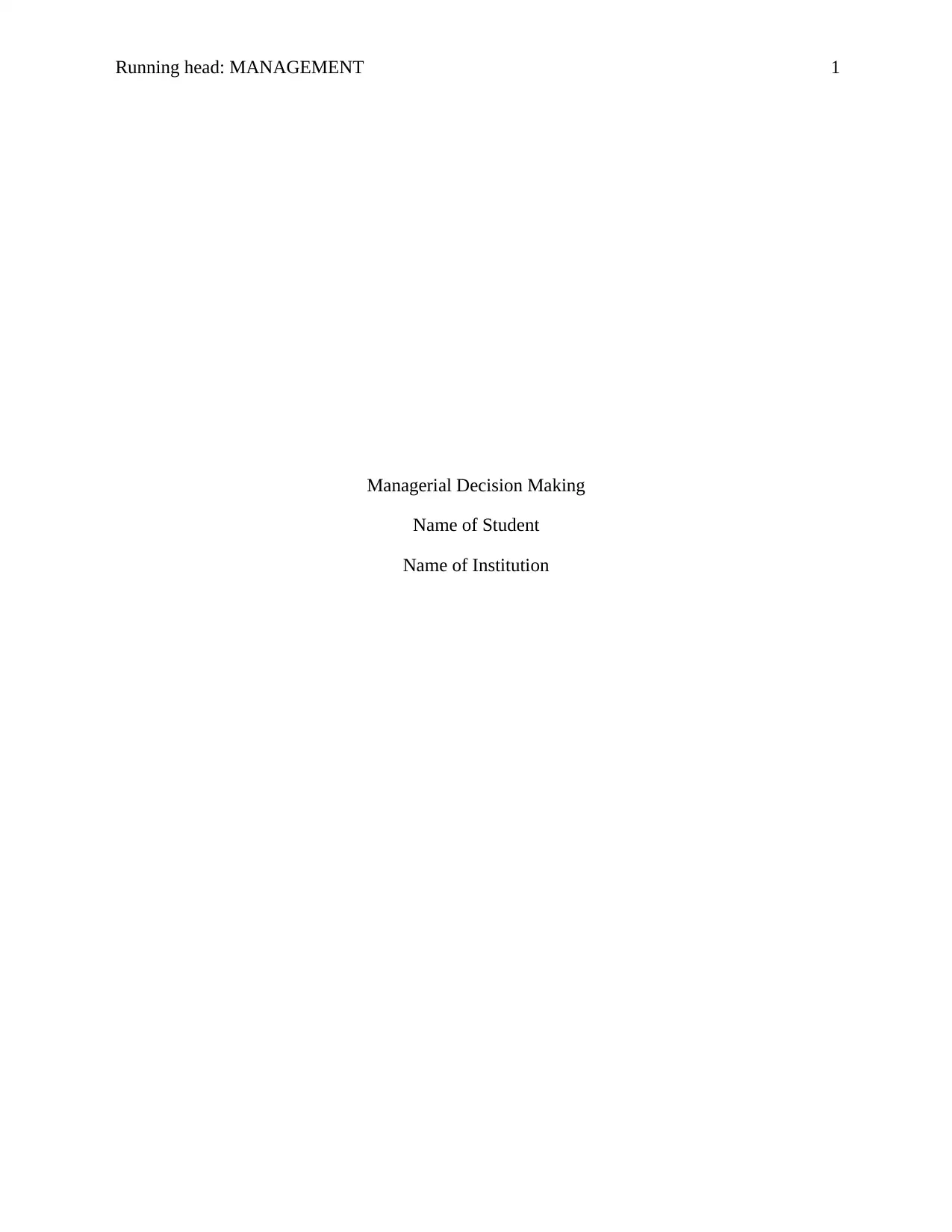
Running head: MANAGEMENT 1
Managerial Decision Making
Name of Student
Name of Institution
Managerial Decision Making
Name of Student
Name of Institution
Paraphrase This Document
Need a fresh take? Get an instant paraphrase of this document with our AI Paraphraser
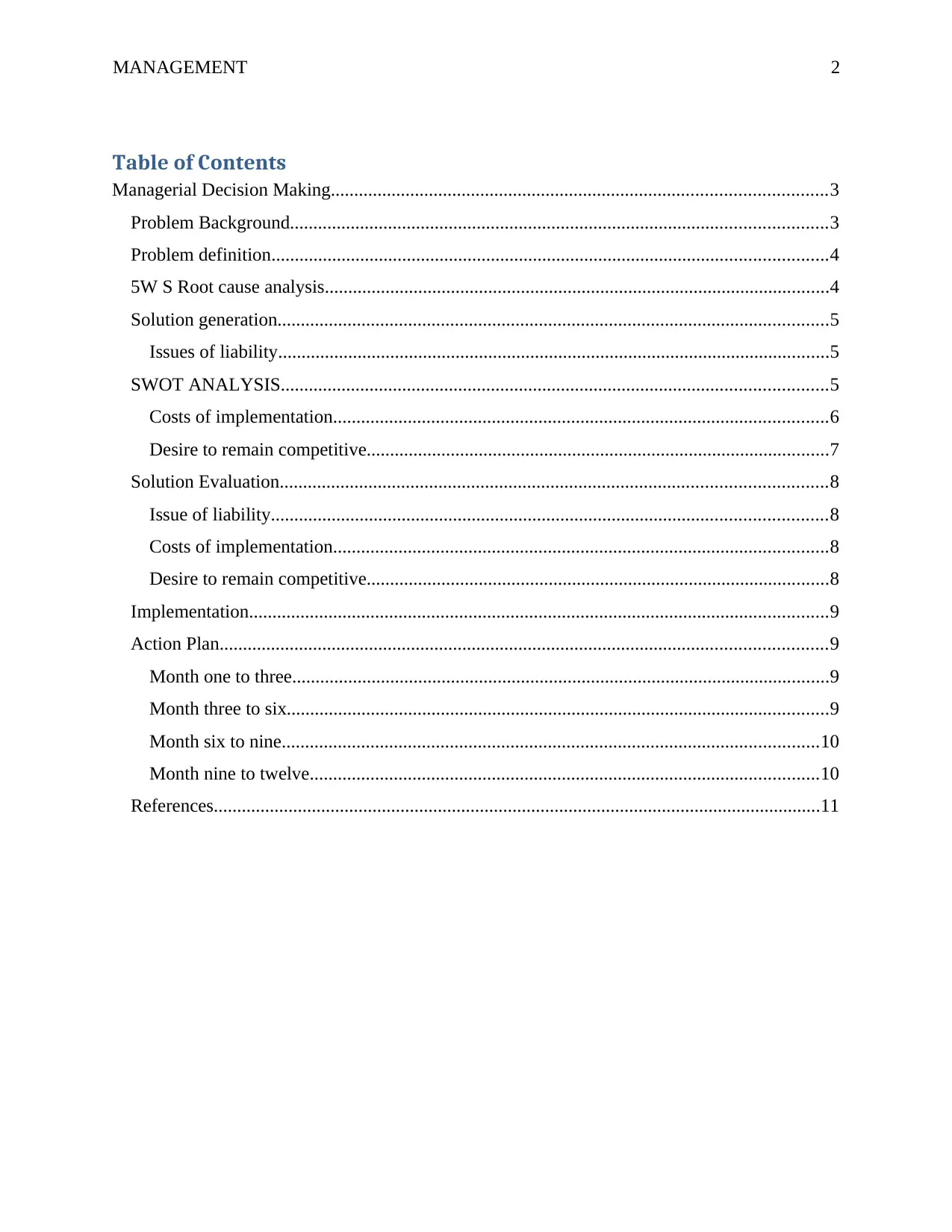
MANAGEMENT 2
Table of Contents
Managerial Decision Making..........................................................................................................3
Problem Background...................................................................................................................3
Problem definition.......................................................................................................................4
5W S Root cause analysis............................................................................................................4
Solution generation......................................................................................................................5
Issues of liability......................................................................................................................5
SWOT ANALYSIS.....................................................................................................................5
Costs of implementation..........................................................................................................6
Desire to remain competitive...................................................................................................7
Solution Evaluation.....................................................................................................................8
Issue of liability.......................................................................................................................8
Costs of implementation..........................................................................................................8
Desire to remain competitive...................................................................................................8
Implementation............................................................................................................................9
Action Plan..................................................................................................................................9
Month one to three...................................................................................................................9
Month three to six....................................................................................................................9
Month six to nine...................................................................................................................10
Month nine to twelve.............................................................................................................10
References..................................................................................................................................11
Table of Contents
Managerial Decision Making..........................................................................................................3
Problem Background...................................................................................................................3
Problem definition.......................................................................................................................4
5W S Root cause analysis............................................................................................................4
Solution generation......................................................................................................................5
Issues of liability......................................................................................................................5
SWOT ANALYSIS.....................................................................................................................5
Costs of implementation..........................................................................................................6
Desire to remain competitive...................................................................................................7
Solution Evaluation.....................................................................................................................8
Issue of liability.......................................................................................................................8
Costs of implementation..........................................................................................................8
Desire to remain competitive...................................................................................................8
Implementation............................................................................................................................9
Action Plan..................................................................................................................................9
Month one to three...................................................................................................................9
Month three to six....................................................................................................................9
Month six to nine...................................................................................................................10
Month nine to twelve.............................................................................................................10
References..................................................................................................................................11
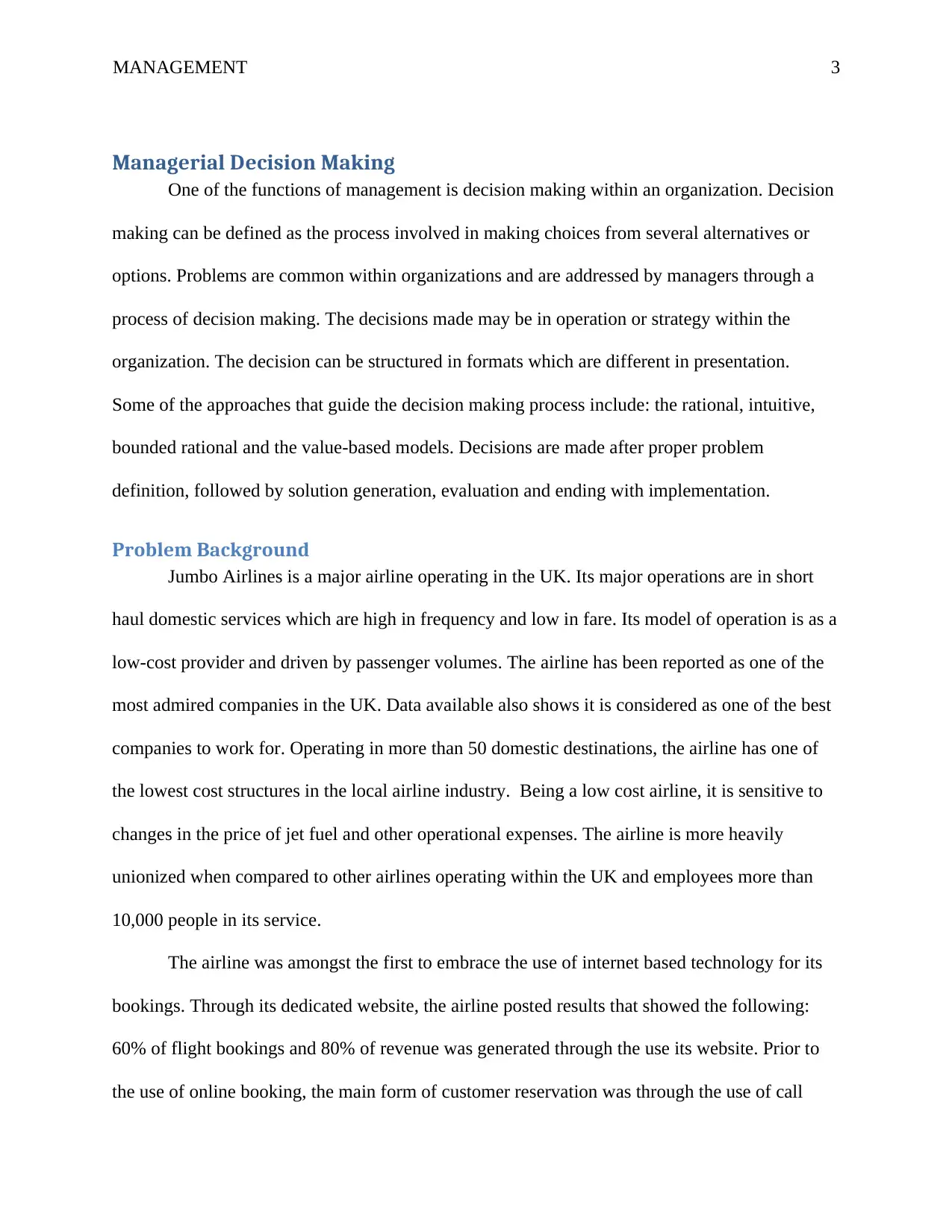
MANAGEMENT 3
Managerial Decision Making
One of the functions of management is decision making within an organization. Decision
making can be defined as the process involved in making choices from several alternatives or
options. Problems are common within organizations and are addressed by managers through a
process of decision making. The decisions made may be in operation or strategy within the
organization. The decision can be structured in formats which are different in presentation.
Some of the approaches that guide the decision making process include: the rational, intuitive,
bounded rational and the value-based models. Decisions are made after proper problem
definition, followed by solution generation, evaluation and ending with implementation.
Problem Background
Jumbo Airlines is a major airline operating in the UK. Its major operations are in short
haul domestic services which are high in frequency and low in fare. Its model of operation is as a
low-cost provider and driven by passenger volumes. The airline has been reported as one of the
most admired companies in the UK. Data available also shows it is considered as one of the best
companies to work for. Operating in more than 50 domestic destinations, the airline has one of
the lowest cost structures in the local airline industry. Being a low cost airline, it is sensitive to
changes in the price of jet fuel and other operational expenses. The airline is more heavily
unionized when compared to other airlines operating within the UK and employees more than
10,000 people in its service.
The airline was amongst the first to embrace the use of internet based technology for its
bookings. Through its dedicated website, the airline posted results that showed the following:
60% of flight bookings and 80% of revenue was generated through the use its website. Prior to
the use of online booking, the main form of customer reservation was through the use of call
Managerial Decision Making
One of the functions of management is decision making within an organization. Decision
making can be defined as the process involved in making choices from several alternatives or
options. Problems are common within organizations and are addressed by managers through a
process of decision making. The decisions made may be in operation or strategy within the
organization. The decision can be structured in formats which are different in presentation.
Some of the approaches that guide the decision making process include: the rational, intuitive,
bounded rational and the value-based models. Decisions are made after proper problem
definition, followed by solution generation, evaluation and ending with implementation.
Problem Background
Jumbo Airlines is a major airline operating in the UK. Its major operations are in short
haul domestic services which are high in frequency and low in fare. Its model of operation is as a
low-cost provider and driven by passenger volumes. The airline has been reported as one of the
most admired companies in the UK. Data available also shows it is considered as one of the best
companies to work for. Operating in more than 50 domestic destinations, the airline has one of
the lowest cost structures in the local airline industry. Being a low cost airline, it is sensitive to
changes in the price of jet fuel and other operational expenses. The airline is more heavily
unionized when compared to other airlines operating within the UK and employees more than
10,000 people in its service.
The airline was amongst the first to embrace the use of internet based technology for its
bookings. Through its dedicated website, the airline posted results that showed the following:
60% of flight bookings and 80% of revenue was generated through the use its website. Prior to
the use of online booking, the main form of customer reservation was through the use of call
⊘ This is a preview!⊘
Do you want full access?
Subscribe today to unlock all pages.

Trusted by 1+ million students worldwide
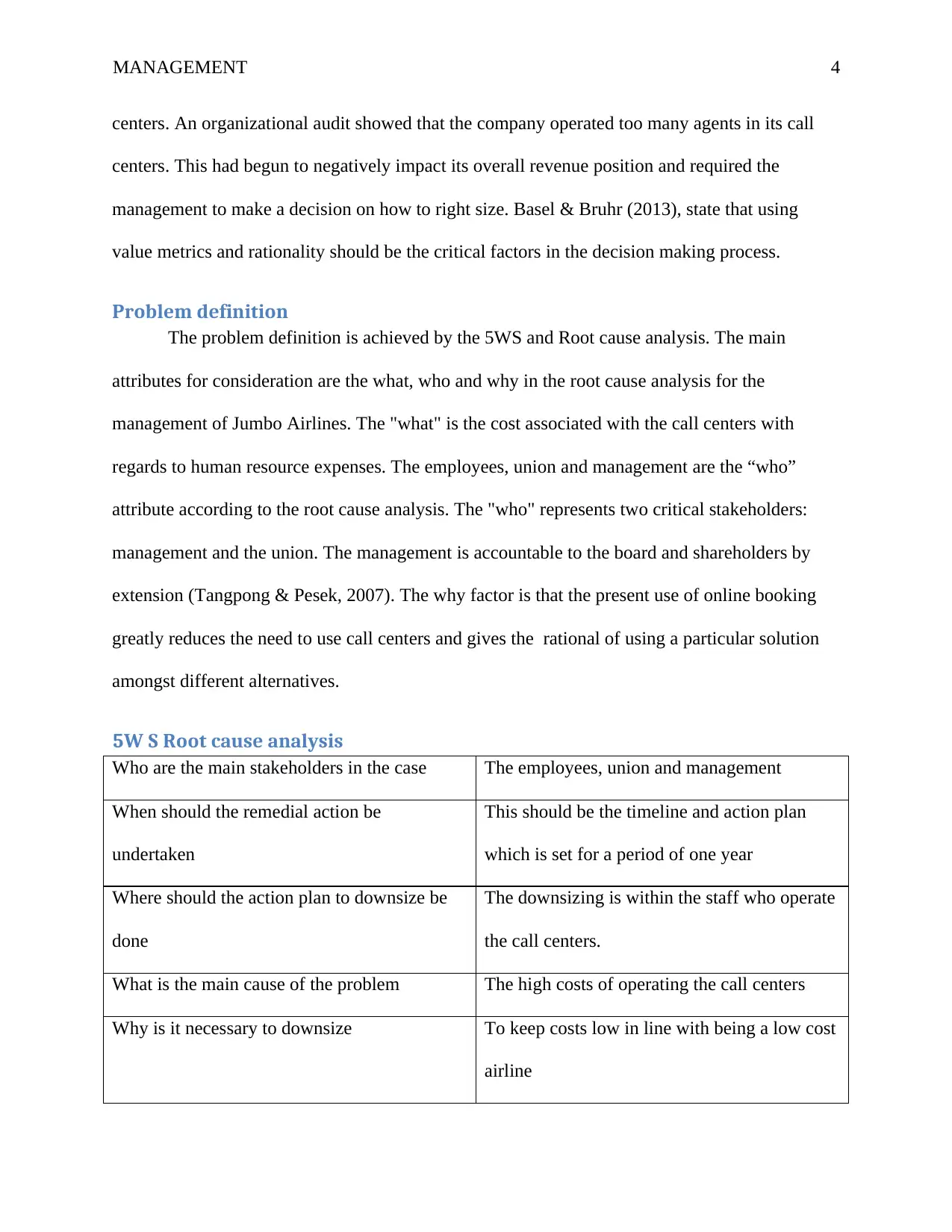
MANAGEMENT 4
centers. An organizational audit showed that the company operated too many agents in its call
centers. This had begun to negatively impact its overall revenue position and required the
management to make a decision on how to right size. Basel & Bruhr (2013), state that using
value metrics and rationality should be the critical factors in the decision making process.
Problem definition
The problem definition is achieved by the 5WS and Root cause analysis. The main
attributes for consideration are the what, who and why in the root cause analysis for the
management of Jumbo Airlines. The "what" is the cost associated with the call centers with
regards to human resource expenses. The employees, union and management are the “who”
attribute according to the root cause analysis. The "who" represents two critical stakeholders:
management and the union. The management is accountable to the board and shareholders by
extension (Tangpong & Pesek, 2007). The why factor is that the present use of online booking
greatly reduces the need to use call centers and gives the rational of using a particular solution
amongst different alternatives.
5W S Root cause analysis
Who are the main stakeholders in the case The employees, union and management
When should the remedial action be
undertaken
This should be the timeline and action plan
which is set for a period of one year
Where should the action plan to downsize be
done
The downsizing is within the staff who operate
the call centers.
What is the main cause of the problem The high costs of operating the call centers
Why is it necessary to downsize To keep costs low in line with being a low cost
airline
centers. An organizational audit showed that the company operated too many agents in its call
centers. This had begun to negatively impact its overall revenue position and required the
management to make a decision on how to right size. Basel & Bruhr (2013), state that using
value metrics and rationality should be the critical factors in the decision making process.
Problem definition
The problem definition is achieved by the 5WS and Root cause analysis. The main
attributes for consideration are the what, who and why in the root cause analysis for the
management of Jumbo Airlines. The "what" is the cost associated with the call centers with
regards to human resource expenses. The employees, union and management are the “who”
attribute according to the root cause analysis. The "who" represents two critical stakeholders:
management and the union. The management is accountable to the board and shareholders by
extension (Tangpong & Pesek, 2007). The why factor is that the present use of online booking
greatly reduces the need to use call centers and gives the rational of using a particular solution
amongst different alternatives.
5W S Root cause analysis
Who are the main stakeholders in the case The employees, union and management
When should the remedial action be
undertaken
This should be the timeline and action plan
which is set for a period of one year
Where should the action plan to downsize be
done
The downsizing is within the staff who operate
the call centers.
What is the main cause of the problem The high costs of operating the call centers
Why is it necessary to downsize To keep costs low in line with being a low cost
airline
Paraphrase This Document
Need a fresh take? Get an instant paraphrase of this document with our AI Paraphraser
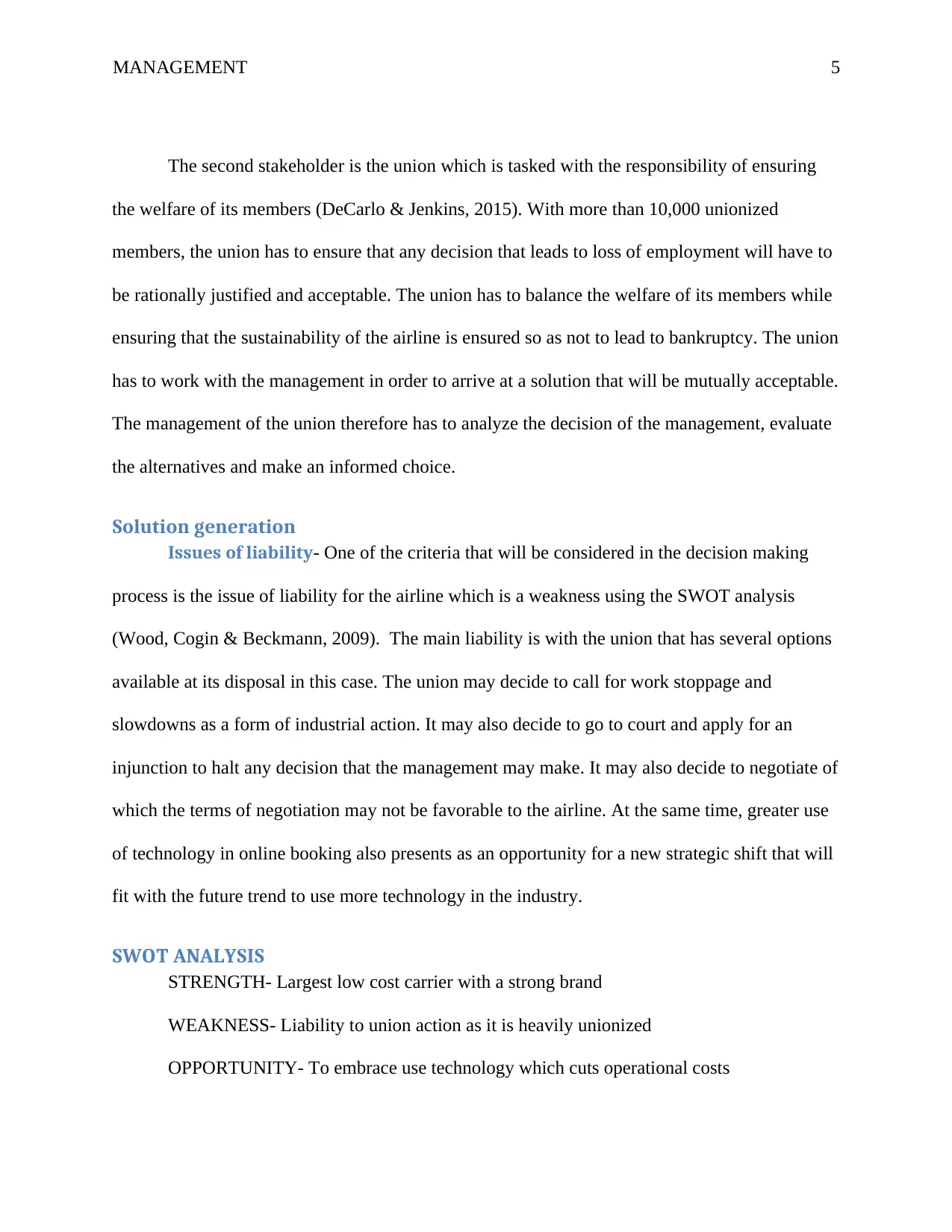
MANAGEMENT 5
The second stakeholder is the union which is tasked with the responsibility of ensuring
the welfare of its members (DeCarlo & Jenkins, 2015). With more than 10,000 unionized
members, the union has to ensure that any decision that leads to loss of employment will have to
be rationally justified and acceptable. The union has to balance the welfare of its members while
ensuring that the sustainability of the airline is ensured so as not to lead to bankruptcy. The union
has to work with the management in order to arrive at a solution that will be mutually acceptable.
The management of the union therefore has to analyze the decision of the management, evaluate
the alternatives and make an informed choice.
Solution generation
Issues of liability- One of the criteria that will be considered in the decision making
process is the issue of liability for the airline which is a weakness using the SWOT analysis
(Wood, Cogin & Beckmann, 2009). The main liability is with the union that has several options
available at its disposal in this case. The union may decide to call for work stoppage and
slowdowns as a form of industrial action. It may also decide to go to court and apply for an
injunction to halt any decision that the management may make. It may also decide to negotiate of
which the terms of negotiation may not be favorable to the airline. At the same time, greater use
of technology in online booking also presents as an opportunity for a new strategic shift that will
fit with the future trend to use more technology in the industry.
SWOT ANALYSIS
STRENGTH- Largest low cost carrier with a strong brand
WEAKNESS- Liability to union action as it is heavily unionized
OPPORTUNITY- To embrace use technology which cuts operational costs
The second stakeholder is the union which is tasked with the responsibility of ensuring
the welfare of its members (DeCarlo & Jenkins, 2015). With more than 10,000 unionized
members, the union has to ensure that any decision that leads to loss of employment will have to
be rationally justified and acceptable. The union has to balance the welfare of its members while
ensuring that the sustainability of the airline is ensured so as not to lead to bankruptcy. The union
has to work with the management in order to arrive at a solution that will be mutually acceptable.
The management of the union therefore has to analyze the decision of the management, evaluate
the alternatives and make an informed choice.
Solution generation
Issues of liability- One of the criteria that will be considered in the decision making
process is the issue of liability for the airline which is a weakness using the SWOT analysis
(Wood, Cogin & Beckmann, 2009). The main liability is with the union that has several options
available at its disposal in this case. The union may decide to call for work stoppage and
slowdowns as a form of industrial action. It may also decide to go to court and apply for an
injunction to halt any decision that the management may make. It may also decide to negotiate of
which the terms of negotiation may not be favorable to the airline. At the same time, greater use
of technology in online booking also presents as an opportunity for a new strategic shift that will
fit with the future trend to use more technology in the industry.
SWOT ANALYSIS
STRENGTH- Largest low cost carrier with a strong brand
WEAKNESS- Liability to union action as it is heavily unionized
OPPORTUNITY- To embrace use technology which cuts operational costs
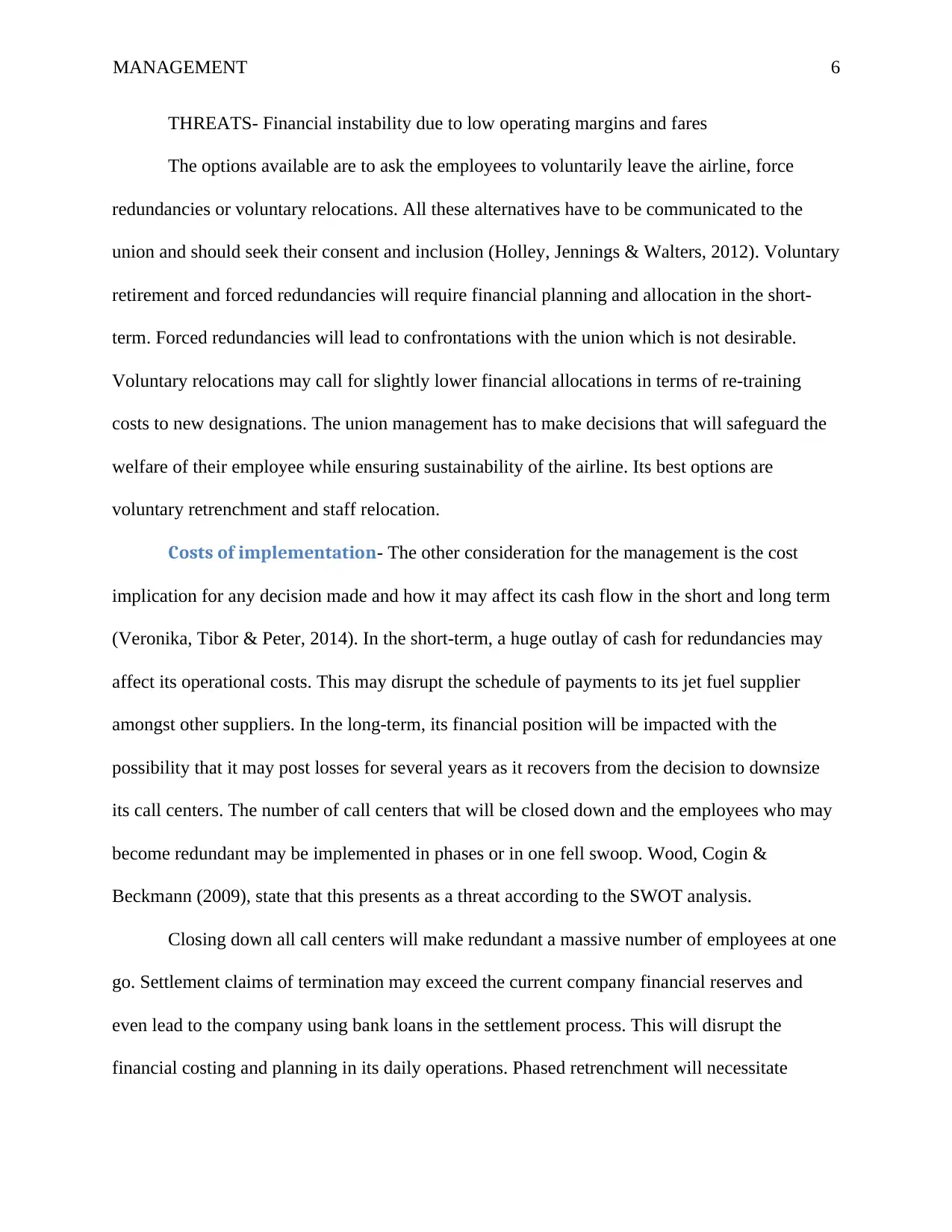
MANAGEMENT 6
THREATS- Financial instability due to low operating margins and fares
The options available are to ask the employees to voluntarily leave the airline, force
redundancies or voluntary relocations. All these alternatives have to be communicated to the
union and should seek their consent and inclusion (Holley, Jennings & Walters, 2012). Voluntary
retirement and forced redundancies will require financial planning and allocation in the short-
term. Forced redundancies will lead to confrontations with the union which is not desirable.
Voluntary relocations may call for slightly lower financial allocations in terms of re-training
costs to new designations. The union management has to make decisions that will safeguard the
welfare of their employee while ensuring sustainability of the airline. Its best options are
voluntary retrenchment and staff relocation.
Costs of implementation- The other consideration for the management is the cost
implication for any decision made and how it may affect its cash flow in the short and long term
(Veronika, Tibor & Peter, 2014). In the short-term, a huge outlay of cash for redundancies may
affect its operational costs. This may disrupt the schedule of payments to its jet fuel supplier
amongst other suppliers. In the long-term, its financial position will be impacted with the
possibility that it may post losses for several years as it recovers from the decision to downsize
its call centers. The number of call centers that will be closed down and the employees who may
become redundant may be implemented in phases or in one fell swoop. Wood, Cogin &
Beckmann (2009), state that this presents as a threat according to the SWOT analysis.
Closing down all call centers will make redundant a massive number of employees at one
go. Settlement claims of termination may exceed the current company financial reserves and
even lead to the company using bank loans in the settlement process. This will disrupt the
financial costing and planning in its daily operations. Phased retrenchment will necessitate
THREATS- Financial instability due to low operating margins and fares
The options available are to ask the employees to voluntarily leave the airline, force
redundancies or voluntary relocations. All these alternatives have to be communicated to the
union and should seek their consent and inclusion (Holley, Jennings & Walters, 2012). Voluntary
retirement and forced redundancies will require financial planning and allocation in the short-
term. Forced redundancies will lead to confrontations with the union which is not desirable.
Voluntary relocations may call for slightly lower financial allocations in terms of re-training
costs to new designations. The union management has to make decisions that will safeguard the
welfare of their employee while ensuring sustainability of the airline. Its best options are
voluntary retrenchment and staff relocation.
Costs of implementation- The other consideration for the management is the cost
implication for any decision made and how it may affect its cash flow in the short and long term
(Veronika, Tibor & Peter, 2014). In the short-term, a huge outlay of cash for redundancies may
affect its operational costs. This may disrupt the schedule of payments to its jet fuel supplier
amongst other suppliers. In the long-term, its financial position will be impacted with the
possibility that it may post losses for several years as it recovers from the decision to downsize
its call centers. The number of call centers that will be closed down and the employees who may
become redundant may be implemented in phases or in one fell swoop. Wood, Cogin &
Beckmann (2009), state that this presents as a threat according to the SWOT analysis.
Closing down all call centers will make redundant a massive number of employees at one
go. Settlement claims of termination may exceed the current company financial reserves and
even lead to the company using bank loans in the settlement process. This will disrupt the
financial costing and planning in its daily operations. Phased retrenchment will necessitate
⊘ This is a preview!⊘
Do you want full access?
Subscribe today to unlock all pages.

Trusted by 1+ million students worldwide
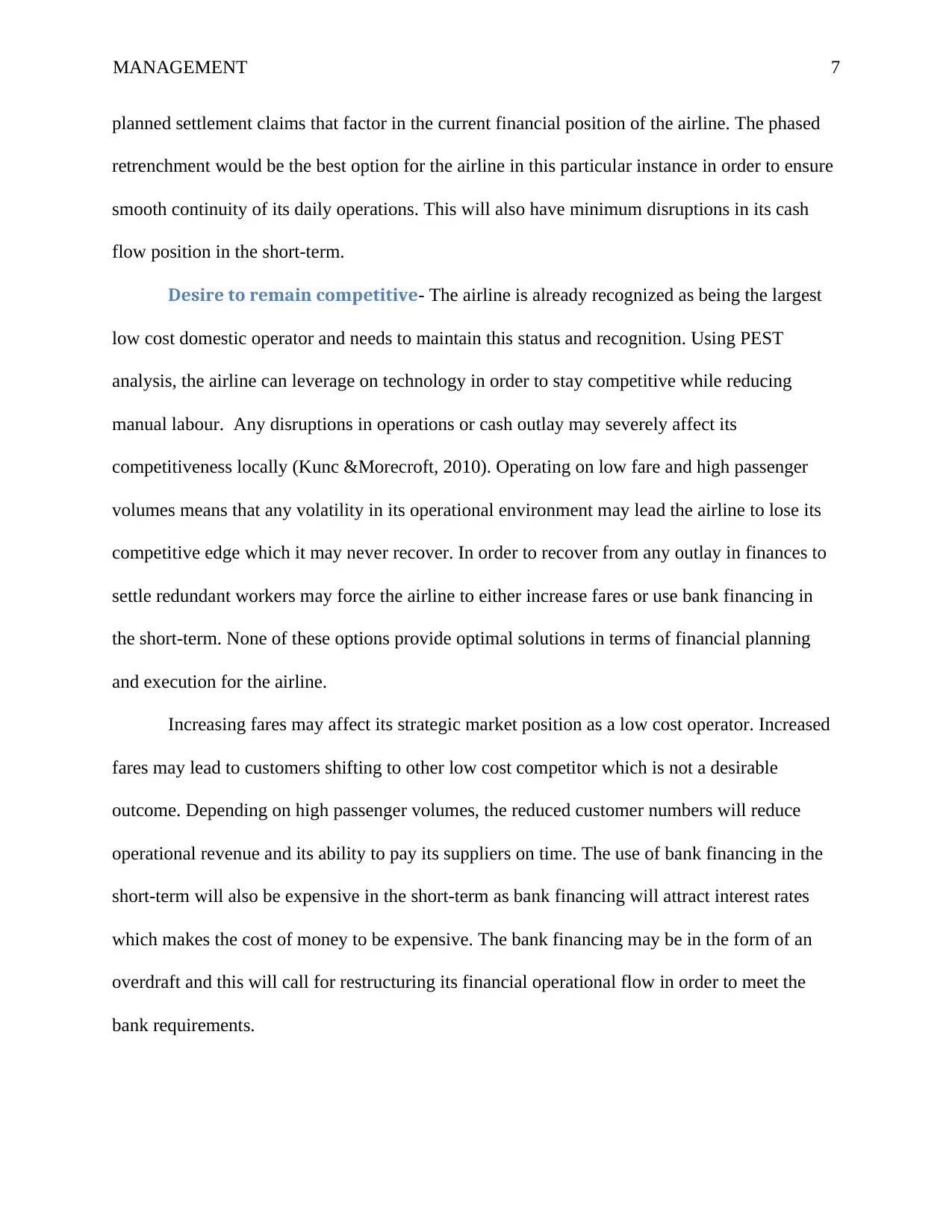
MANAGEMENT 7
planned settlement claims that factor in the current financial position of the airline. The phased
retrenchment would be the best option for the airline in this particular instance in order to ensure
smooth continuity of its daily operations. This will also have minimum disruptions in its cash
flow position in the short-term.
Desire to remain competitive- The airline is already recognized as being the largest
low cost domestic operator and needs to maintain this status and recognition. Using PEST
analysis, the airline can leverage on technology in order to stay competitive while reducing
manual labour. Any disruptions in operations or cash outlay may severely affect its
competitiveness locally (Kunc &Morecroft, 2010). Operating on low fare and high passenger
volumes means that any volatility in its operational environment may lead the airline to lose its
competitive edge which it may never recover. In order to recover from any outlay in finances to
settle redundant workers may force the airline to either increase fares or use bank financing in
the short-term. None of these options provide optimal solutions in terms of financial planning
and execution for the airline.
Increasing fares may affect its strategic market position as a low cost operator. Increased
fares may lead to customers shifting to other low cost competitor which is not a desirable
outcome. Depending on high passenger volumes, the reduced customer numbers will reduce
operational revenue and its ability to pay its suppliers on time. The use of bank financing in the
short-term will also be expensive in the short-term as bank financing will attract interest rates
which makes the cost of money to be expensive. The bank financing may be in the form of an
overdraft and this will call for restructuring its financial operational flow in order to meet the
bank requirements.
planned settlement claims that factor in the current financial position of the airline. The phased
retrenchment would be the best option for the airline in this particular instance in order to ensure
smooth continuity of its daily operations. This will also have minimum disruptions in its cash
flow position in the short-term.
Desire to remain competitive- The airline is already recognized as being the largest
low cost domestic operator and needs to maintain this status and recognition. Using PEST
analysis, the airline can leverage on technology in order to stay competitive while reducing
manual labour. Any disruptions in operations or cash outlay may severely affect its
competitiveness locally (Kunc &Morecroft, 2010). Operating on low fare and high passenger
volumes means that any volatility in its operational environment may lead the airline to lose its
competitive edge which it may never recover. In order to recover from any outlay in finances to
settle redundant workers may force the airline to either increase fares or use bank financing in
the short-term. None of these options provide optimal solutions in terms of financial planning
and execution for the airline.
Increasing fares may affect its strategic market position as a low cost operator. Increased
fares may lead to customers shifting to other low cost competitor which is not a desirable
outcome. Depending on high passenger volumes, the reduced customer numbers will reduce
operational revenue and its ability to pay its suppliers on time. The use of bank financing in the
short-term will also be expensive in the short-term as bank financing will attract interest rates
which makes the cost of money to be expensive. The bank financing may be in the form of an
overdraft and this will call for restructuring its financial operational flow in order to meet the
bank requirements.
Paraphrase This Document
Need a fresh take? Get an instant paraphrase of this document with our AI Paraphraser
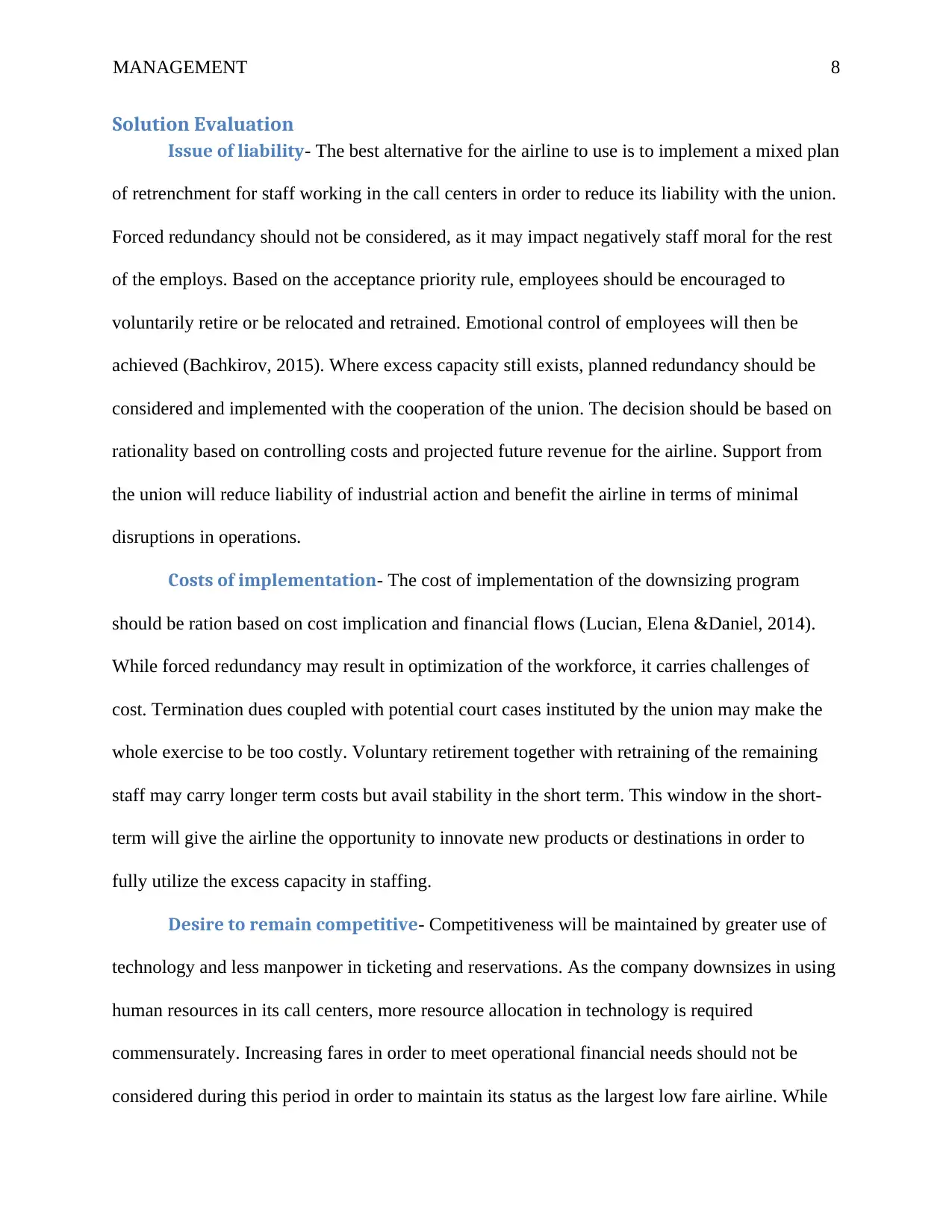
MANAGEMENT 8
Solution Evaluation
Issue of liability- The best alternative for the airline to use is to implement a mixed plan
of retrenchment for staff working in the call centers in order to reduce its liability with the union.
Forced redundancy should not be considered, as it may impact negatively staff moral for the rest
of the employs. Based on the acceptance priority rule, employees should be encouraged to
voluntarily retire or be relocated and retrained. Emotional control of employees will then be
achieved (Bachkirov, 2015). Where excess capacity still exists, planned redundancy should be
considered and implemented with the cooperation of the union. The decision should be based on
rationality based on controlling costs and projected future revenue for the airline. Support from
the union will reduce liability of industrial action and benefit the airline in terms of minimal
disruptions in operations.
Costs of implementation- The cost of implementation of the downsizing program
should be ration based on cost implication and financial flows (Lucian, Elena &Daniel, 2014).
While forced redundancy may result in optimization of the workforce, it carries challenges of
cost. Termination dues coupled with potential court cases instituted by the union may make the
whole exercise to be too costly. Voluntary retirement together with retraining of the remaining
staff may carry longer term costs but avail stability in the short term. This window in the short-
term will give the airline the opportunity to innovate new products or destinations in order to
fully utilize the excess capacity in staffing.
Desire to remain competitive- Competitiveness will be maintained by greater use of
technology and less manpower in ticketing and reservations. As the company downsizes in using
human resources in its call centers, more resource allocation in technology is required
commensurately. Increasing fares in order to meet operational financial needs should not be
considered during this period in order to maintain its status as the largest low fare airline. While
Solution Evaluation
Issue of liability- The best alternative for the airline to use is to implement a mixed plan
of retrenchment for staff working in the call centers in order to reduce its liability with the union.
Forced redundancy should not be considered, as it may impact negatively staff moral for the rest
of the employs. Based on the acceptance priority rule, employees should be encouraged to
voluntarily retire or be relocated and retrained. Emotional control of employees will then be
achieved (Bachkirov, 2015). Where excess capacity still exists, planned redundancy should be
considered and implemented with the cooperation of the union. The decision should be based on
rationality based on controlling costs and projected future revenue for the airline. Support from
the union will reduce liability of industrial action and benefit the airline in terms of minimal
disruptions in operations.
Costs of implementation- The cost of implementation of the downsizing program
should be ration based on cost implication and financial flows (Lucian, Elena &Daniel, 2014).
While forced redundancy may result in optimization of the workforce, it carries challenges of
cost. Termination dues coupled with potential court cases instituted by the union may make the
whole exercise to be too costly. Voluntary retirement together with retraining of the remaining
staff may carry longer term costs but avail stability in the short term. This window in the short-
term will give the airline the opportunity to innovate new products or destinations in order to
fully utilize the excess capacity in staffing.
Desire to remain competitive- Competitiveness will be maintained by greater use of
technology and less manpower in ticketing and reservations. As the company downsizes in using
human resources in its call centers, more resource allocation in technology is required
commensurately. Increasing fares in order to meet operational financial needs should not be
considered during this period in order to maintain its status as the largest low fare airline. While
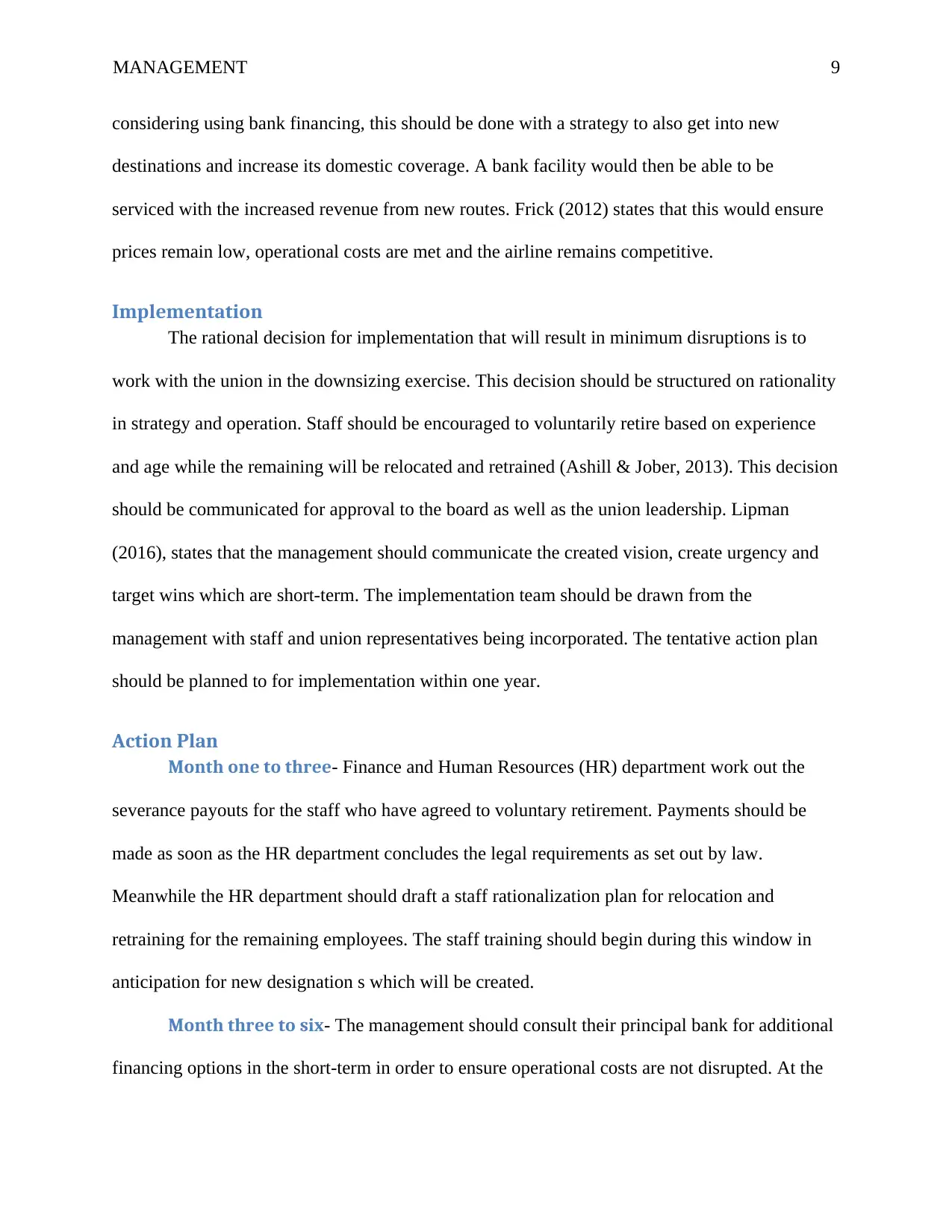
MANAGEMENT 9
considering using bank financing, this should be done with a strategy to also get into new
destinations and increase its domestic coverage. A bank facility would then be able to be
serviced with the increased revenue from new routes. Frick (2012) states that this would ensure
prices remain low, operational costs are met and the airline remains competitive.
Implementation
The rational decision for implementation that will result in minimum disruptions is to
work with the union in the downsizing exercise. This decision should be structured on rationality
in strategy and operation. Staff should be encouraged to voluntarily retire based on experience
and age while the remaining will be relocated and retrained (Ashill & Jober, 2013). This decision
should be communicated for approval to the board as well as the union leadership. Lipman
(2016), states that the management should communicate the created vision, create urgency and
target wins which are short-term. The implementation team should be drawn from the
management with staff and union representatives being incorporated. The tentative action plan
should be planned to for implementation within one year.
Action Plan
Month one to three- Finance and Human Resources (HR) department work out the
severance payouts for the staff who have agreed to voluntary retirement. Payments should be
made as soon as the HR department concludes the legal requirements as set out by law.
Meanwhile the HR department should draft a staff rationalization plan for relocation and
retraining for the remaining employees. The staff training should begin during this window in
anticipation for new designation s which will be created.
Month three to six- The management should consult their principal bank for additional
financing options in the short-term in order to ensure operational costs are not disrupted. At the
considering using bank financing, this should be done with a strategy to also get into new
destinations and increase its domestic coverage. A bank facility would then be able to be
serviced with the increased revenue from new routes. Frick (2012) states that this would ensure
prices remain low, operational costs are met and the airline remains competitive.
Implementation
The rational decision for implementation that will result in minimum disruptions is to
work with the union in the downsizing exercise. This decision should be structured on rationality
in strategy and operation. Staff should be encouraged to voluntarily retire based on experience
and age while the remaining will be relocated and retrained (Ashill & Jober, 2013). This decision
should be communicated for approval to the board as well as the union leadership. Lipman
(2016), states that the management should communicate the created vision, create urgency and
target wins which are short-term. The implementation team should be drawn from the
management with staff and union representatives being incorporated. The tentative action plan
should be planned to for implementation within one year.
Action Plan
Month one to three- Finance and Human Resources (HR) department work out the
severance payouts for the staff who have agreed to voluntary retirement. Payments should be
made as soon as the HR department concludes the legal requirements as set out by law.
Meanwhile the HR department should draft a staff rationalization plan for relocation and
retraining for the remaining employees. The staff training should begin during this window in
anticipation for new designation s which will be created.
Month three to six- The management should consult their principal bank for additional
financing options in the short-term in order to ensure operational costs are not disrupted. At the
⊘ This is a preview!⊘
Do you want full access?
Subscribe today to unlock all pages.

Trusted by 1+ million students worldwide
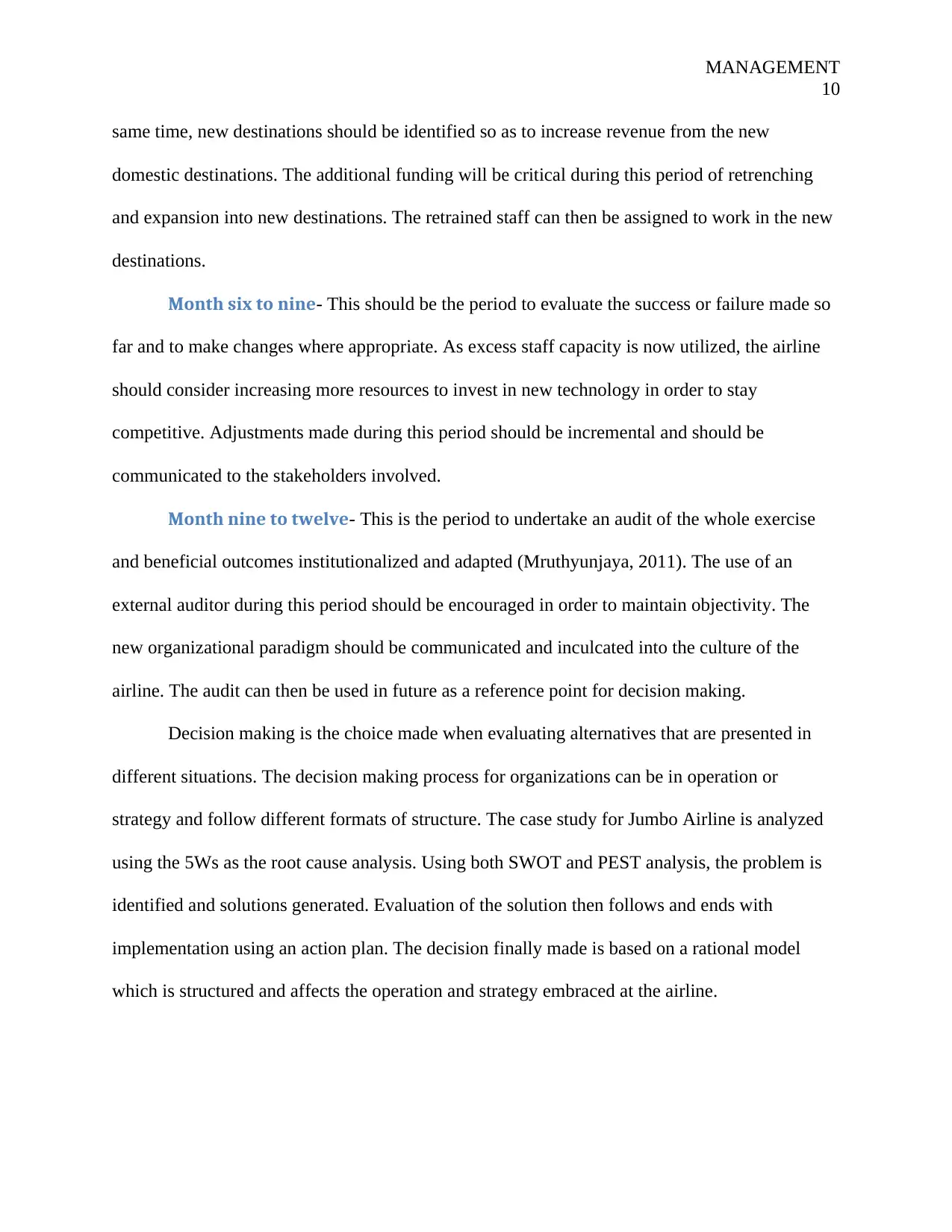
MANAGEMENT
10
same time, new destinations should be identified so as to increase revenue from the new
domestic destinations. The additional funding will be critical during this period of retrenching
and expansion into new destinations. The retrained staff can then be assigned to work in the new
destinations.
Month six to nine- This should be the period to evaluate the success or failure made so
far and to make changes where appropriate. As excess staff capacity is now utilized, the airline
should consider increasing more resources to invest in new technology in order to stay
competitive. Adjustments made during this period should be incremental and should be
communicated to the stakeholders involved.
Month nine to twelve- This is the period to undertake an audit of the whole exercise
and beneficial outcomes institutionalized and adapted (Mruthyunjaya, 2011). The use of an
external auditor during this period should be encouraged in order to maintain objectivity. The
new organizational paradigm should be communicated and inculcated into the culture of the
airline. The audit can then be used in future as a reference point for decision making.
Decision making is the choice made when evaluating alternatives that are presented in
different situations. The decision making process for organizations can be in operation or
strategy and follow different formats of structure. The case study for Jumbo Airline is analyzed
using the 5Ws as the root cause analysis. Using both SWOT and PEST analysis, the problem is
identified and solutions generated. Evaluation of the solution then follows and ends with
implementation using an action plan. The decision finally made is based on a rational model
which is structured and affects the operation and strategy embraced at the airline.
10
same time, new destinations should be identified so as to increase revenue from the new
domestic destinations. The additional funding will be critical during this period of retrenching
and expansion into new destinations. The retrained staff can then be assigned to work in the new
destinations.
Month six to nine- This should be the period to evaluate the success or failure made so
far and to make changes where appropriate. As excess staff capacity is now utilized, the airline
should consider increasing more resources to invest in new technology in order to stay
competitive. Adjustments made during this period should be incremental and should be
communicated to the stakeholders involved.
Month nine to twelve- This is the period to undertake an audit of the whole exercise
and beneficial outcomes institutionalized and adapted (Mruthyunjaya, 2011). The use of an
external auditor during this period should be encouraged in order to maintain objectivity. The
new organizational paradigm should be communicated and inculcated into the culture of the
airline. The audit can then be used in future as a reference point for decision making.
Decision making is the choice made when evaluating alternatives that are presented in
different situations. The decision making process for organizations can be in operation or
strategy and follow different formats of structure. The case study for Jumbo Airline is analyzed
using the 5Ws as the root cause analysis. Using both SWOT and PEST analysis, the problem is
identified and solutions generated. Evaluation of the solution then follows and ends with
implementation using an action plan. The decision finally made is based on a rational model
which is structured and affects the operation and strategy embraced at the airline.
Paraphrase This Document
Need a fresh take? Get an instant paraphrase of this document with our AI Paraphraser
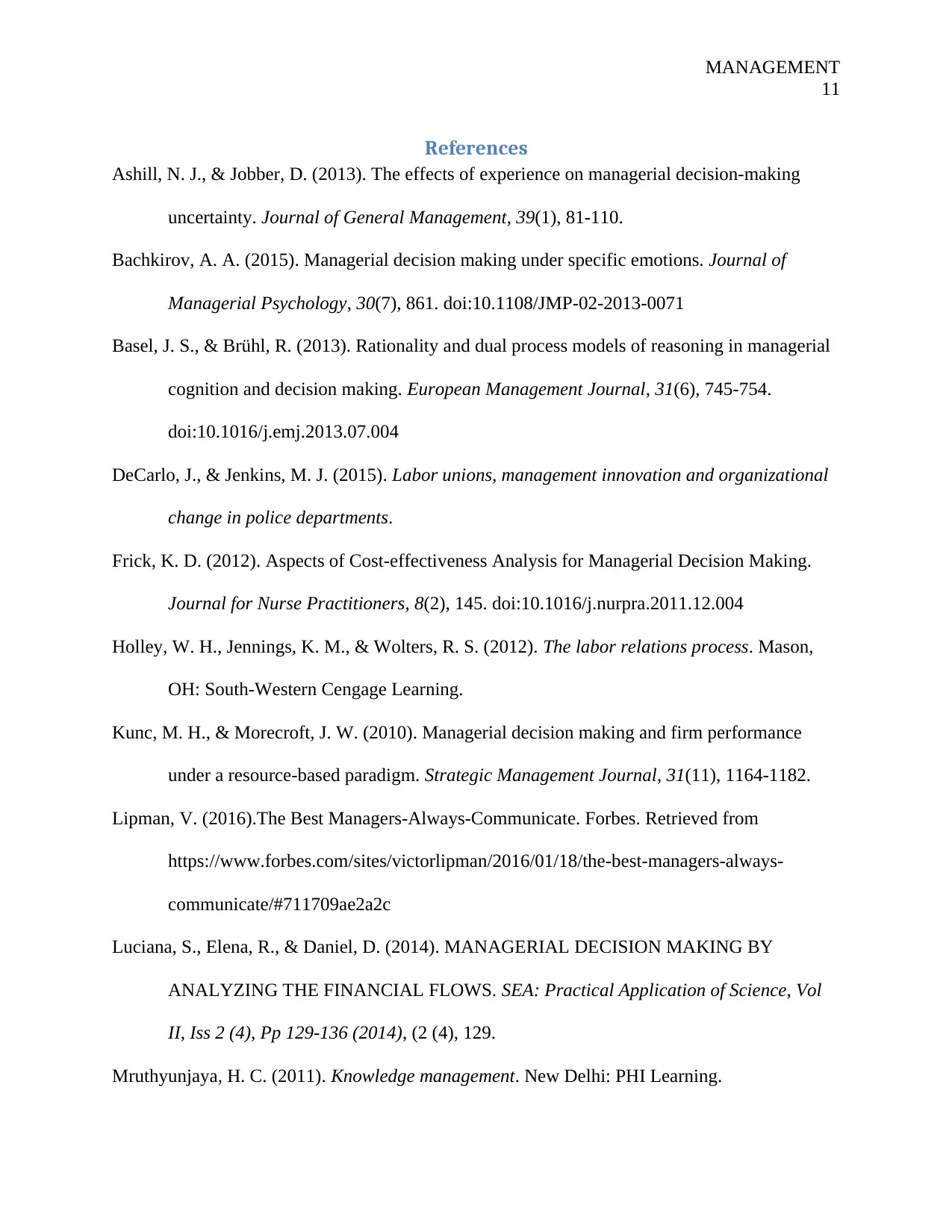
MANAGEMENT
11
References
Ashill, N. J., & Jobber, D. (2013). The effects of experience on managerial decision-making
uncertainty. Journal of General Management, 39(1), 81-110.
Bachkirov, A. A. (2015). Managerial decision making under specific emotions. Journal of
Managerial Psychology, 30(7), 861. doi:10.1108/JMP-02-2013-0071
Basel, J. S., & Brühl, R. (2013). Rationality and dual process models of reasoning in managerial
cognition and decision making. European Management Journal, 31(6), 745-754.
doi:10.1016/j.emj.2013.07.004
DeCarlo, J., & Jenkins, M. J. (2015). Labor unions, management innovation and organizational
change in police departments.
Frick, K. D. (2012). Aspects of Cost-effectiveness Analysis for Managerial Decision Making.
Journal for Nurse Practitioners, 8(2), 145. doi:10.1016/j.nurpra.2011.12.004
Holley, W. H., Jennings, K. M., & Wolters, R. S. (2012). The labor relations process. Mason,
OH: South-Western Cengage Learning.
Kunc, M. H., & Morecroft, J. W. (2010). Managerial decision making and firm performance
under a resource-based paradigm. Strategic Management Journal, 31(11), 1164-1182.
Lipman, V. (2016).The Best Managers-Always-Communicate. Forbes. Retrieved from
https://www.forbes.com/sites/victorlipman/2016/01/18/the-best-managers-always-
communicate/#711709ae2a2c
Luciana, S., Elena, R., & Daniel, D. (2014). MANAGERIAL DECISION MAKING BY
ANALYZING THE FINANCIAL FLOWS. SEA: Practical Application of Science, Vol
II, Iss 2 (4), Pp 129-136 (2014), (2 (4), 129.
Mruthyunjaya, H. C. (2011). Knowledge management. New Delhi: PHI Learning.
11
References
Ashill, N. J., & Jobber, D. (2013). The effects of experience on managerial decision-making
uncertainty. Journal of General Management, 39(1), 81-110.
Bachkirov, A. A. (2015). Managerial decision making under specific emotions. Journal of
Managerial Psychology, 30(7), 861. doi:10.1108/JMP-02-2013-0071
Basel, J. S., & Brühl, R. (2013). Rationality and dual process models of reasoning in managerial
cognition and decision making. European Management Journal, 31(6), 745-754.
doi:10.1016/j.emj.2013.07.004
DeCarlo, J., & Jenkins, M. J. (2015). Labor unions, management innovation and organizational
change in police departments.
Frick, K. D. (2012). Aspects of Cost-effectiveness Analysis for Managerial Decision Making.
Journal for Nurse Practitioners, 8(2), 145. doi:10.1016/j.nurpra.2011.12.004
Holley, W. H., Jennings, K. M., & Wolters, R. S. (2012). The labor relations process. Mason,
OH: South-Western Cengage Learning.
Kunc, M. H., & Morecroft, J. W. (2010). Managerial decision making and firm performance
under a resource-based paradigm. Strategic Management Journal, 31(11), 1164-1182.
Lipman, V. (2016).The Best Managers-Always-Communicate. Forbes. Retrieved from
https://www.forbes.com/sites/victorlipman/2016/01/18/the-best-managers-always-
communicate/#711709ae2a2c
Luciana, S., Elena, R., & Daniel, D. (2014). MANAGERIAL DECISION MAKING BY
ANALYZING THE FINANCIAL FLOWS. SEA: Practical Application of Science, Vol
II, Iss 2 (4), Pp 129-136 (2014), (2 (4), 129.
Mruthyunjaya, H. C. (2011). Knowledge management. New Delhi: PHI Learning.
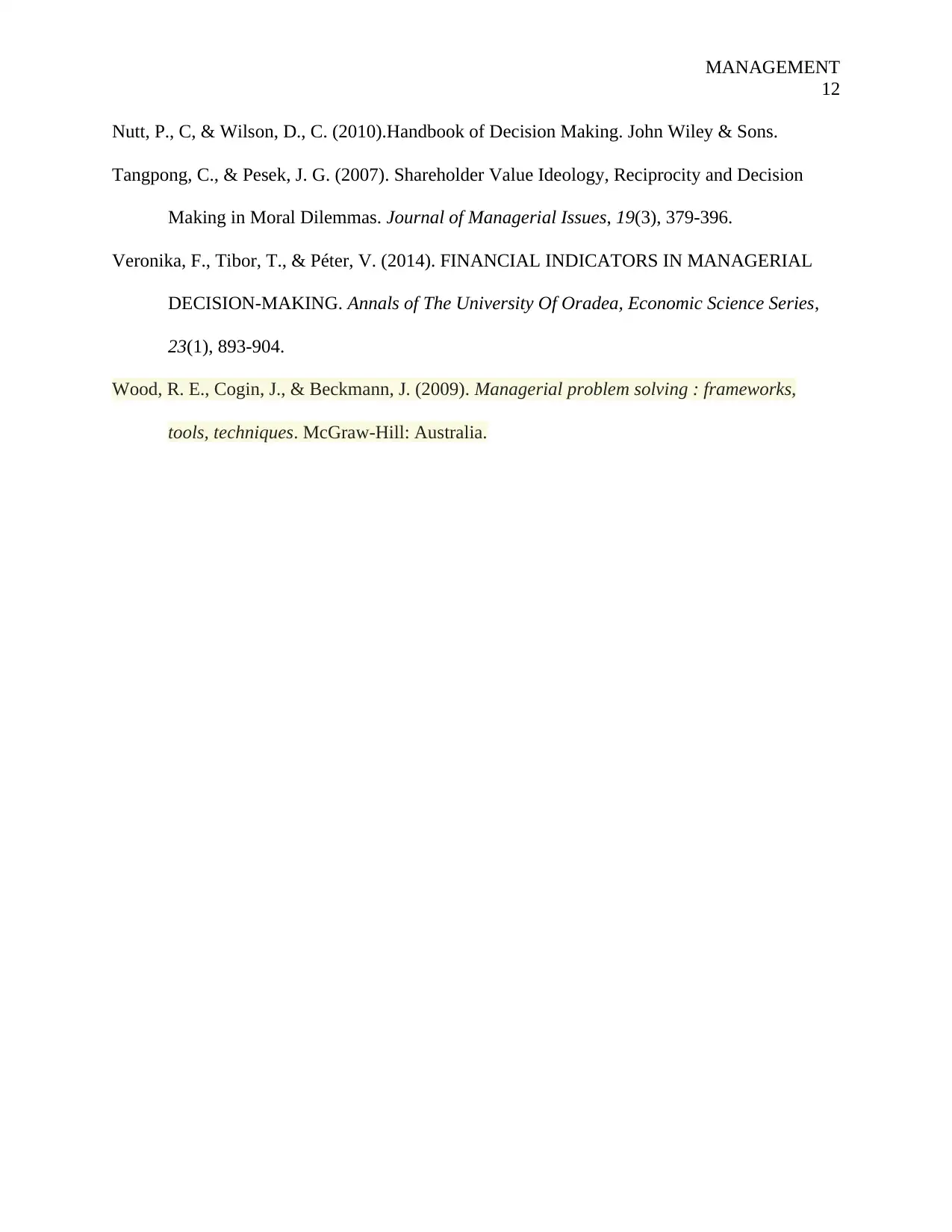
MANAGEMENT
12
Nutt, P., C, & Wilson, D., C. (2010).Handbook of Decision Making. John Wiley & Sons.
Tangpong, C., & Pesek, J. G. (2007). Shareholder Value Ideology, Reciprocity and Decision
Making in Moral Dilemmas. Journal of Managerial Issues, 19(3), 379-396.
Veronika, F., Tibor, T., & Péter, V. (2014). FINANCIAL INDICATORS IN MANAGERIAL
DECISION-MAKING. Annals of The University Of Oradea, Economic Science Series,
23(1), 893-904.
Wood, R. E., Cogin, J., & Beckmann, J. (2009). Managerial problem solving : frameworks,
tools, techniques. McGraw-Hill: Australia.
12
Nutt, P., C, & Wilson, D., C. (2010).Handbook of Decision Making. John Wiley & Sons.
Tangpong, C., & Pesek, J. G. (2007). Shareholder Value Ideology, Reciprocity and Decision
Making in Moral Dilemmas. Journal of Managerial Issues, 19(3), 379-396.
Veronika, F., Tibor, T., & Péter, V. (2014). FINANCIAL INDICATORS IN MANAGERIAL
DECISION-MAKING. Annals of The University Of Oradea, Economic Science Series,
23(1), 893-904.
Wood, R. E., Cogin, J., & Beckmann, J. (2009). Managerial problem solving : frameworks,
tools, techniques. McGraw-Hill: Australia.
⊘ This is a preview!⊘
Do you want full access?
Subscribe today to unlock all pages.

Trusted by 1+ million students worldwide
1 out of 12
Related Documents
Your All-in-One AI-Powered Toolkit for Academic Success.
+13062052269
info@desklib.com
Available 24*7 on WhatsApp / Email
![[object Object]](/_next/static/media/star-bottom.7253800d.svg)
Unlock your academic potential
Copyright © 2020–2025 A2Z Services. All Rights Reserved. Developed and managed by ZUCOL.





